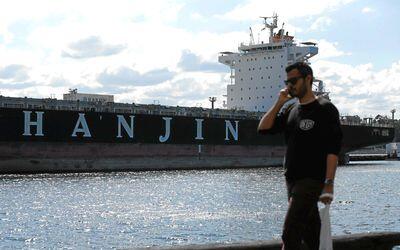The global shipping industry is bracing for a key regulatory decision that could mark a milestone in reducing maritime pollution, but that could nearly double fuel costs in a sector already reeling from its worst downturn in decades.
The shipping industry is by far the biggest emitter of sulphur, with the sulphur oxides content in heavy fuel oil up to 3,500 times higher than the latest European diesel standards for vehicles.
To combat such pollution, the International Maritime Organisation’s (IMO’s) marine environment protection committee will meet in London on October 24-28 to decide whether to impose a global cap on sulphur oxide emissions from 2020 or 2025, which would see sulphur emissions fall from the current maximum of 3.5% of fuel content to 0.5%.
“One large vessel in one day can emit more sulphur dioxide than all the new cars that come onto the world’s roads in a year,” said Thomas Koniordos, the head of business line environmental solutions at Norway’s Yara International.
“That is reason enough to cap emissions,” said Koniordos, whose firm makes scrubbers that clean exhaust emissions.
Large container ships consume up to 300 tonnes of high-sulphur fuel a day at sea, while a supertanker guzzles up to about 100 tonnes per day.
Health experts say sulphur is responsible for deadly heart and lung diseases.
The issue has been brewing for more than a decade and shippers said the industry was bracing for tighter regulation to be introduced sooner rather than later due to political pressure.
“The decision will likely be a political one — the EU is pressing strongly for 2020,” said Arthur Bowring, the MD of the Hong Kong Shipowners’ Association.
The EU has already agreed that the 0.5% sulphur requirement will apply in 2020 within 200 nautical miles of EU member states’ coasts, regardless of what the IMO decides.
China, home to the world’s busiest container ports, is also demanding cleaner fuels.
Authorities in Shenzhen, the world’s third-biggest container port, introduced tighter controls earlier in October, demanding that ships calling there do not use fuel with a sulphur content of more than 0.5%.
Ship owners can comply with the tighter controls either by switching away from the sludgy and sulphur-rich bunker fuels to diesel or liquefied natural gas, or by fitting scrubbers to clean exhaust emissions.
A fuel switch would impose extra costs on an already troubled shipping sector that has experienced high-profile defaults like South Korea’s Hanjin Shipping as well as cases of stranded ships with crew left on board unpaid and unsupplied.
Using low-sulphur diesel instead of bunker fuel on a supertanker would boost fuel costs 44% from an average of $212 per tonne in 2016 for heavy fuel oil to $379 per tonne for gas oil, according to figures from shipping broker Clarkson.
For traded oil markets, the shift to low-sulphur fuel would “substantially reduce demand for bunkers in the run-up to 2020 and increase demand for gas oil and alternative fuels including liquefied natural gas”, said Christopher Haines, the head of oil and gas at BMI Research.











